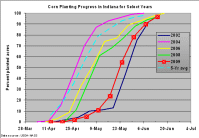Published 18 June 2009
URL: http://www.kingcorn.org/news/articles.09/LatePlanting-0618.html
Time to Park the Corn Planters
R.L. (Bob) Nielsen
Agronomy Dept., Purdue Univ.
West Lafayette, IN 47907-2054
Email address: rnielsen
at purdue.edu

Click image to view a larger version.
![]() s the latest round of thunderstorms rumble through Indiana today dropping more rain on fields that have had more than their fair share of rainfall this spring, even the most staunch defender of the King of Crops has to admit it is time for most growers to throw in the towel with regards to planting the remainder of their intended corn acres. Monday's USDA report (USDA-NASS, June 15 2009) indicated that 97% of the state's corn crop was planted (not counting any replanting), but southern Indiana was a bit further behind with only 90% of the corn crop being reported as planted.
s the latest round of thunderstorms rumble through Indiana today dropping more rain on fields that have had more than their fair share of rainfall this spring, even the most staunch defender of the King of Crops has to admit it is time for most growers to throw in the towel with regards to planting the remainder of their intended corn acres. Monday's USDA report (USDA-NASS, June 15 2009) indicated that 97% of the state's corn crop was planted (not counting any replanting), but southern Indiana was a bit further behind with only 90% of the corn crop being reported as planted.
So here it is June 18 and many fields throughout southern Indiana were too wet to plant before today's rainfall added insult to injury. Most agronomists and farmers would agree that the agronomic viability of planting corn through the rest of this month in central and northern Indiana is essentially non-existent.
Technically, growers in southern Indiana could continue planting corn through June 30 by using short-season relative hybrid maturities ranging from 103-day (southeast, southcentral) to 110-day (southwest). Realistically, though, the risks associated with planting corn this late in southern Indiana, especially southcentral and southeast Indiana, are great enough that most folks should probably put their corn planters away for the season.
The relative hybrid maturities listed above that could be yet planted in southern Indiana are those that should theoretically mature at least by the average date of the first killing frost. For southern Indiana, these dates would be mid- to late-October. Grain that matures that late will not dry very fast in the field and so the harvested grain will require more drying time and expense than usual.
Even early-maturity hybrids planted this late incur substantial risk of stressful weather conditions during flowering and grain filling prior to physiological maturity. Pollination that occurs in early to mid-August can easily experience some of the hottest and driest periods of the growing season. The grain filling period following pollination will also experience the often hot stressful periods of late August and early September that can easily result in lower test weight grain and increased risk of price dockage by grain buyers.
Significant plant stress during grain filling also greatly increases the risk of the development of stalk rots in response to stalk carbohydrate remobilization to the developing ears to compensate for inadequate photosynthesis rates. Thus, the risk of significant stalk lodging prior to harvest is greater with such late-planted corn.
In addition to the risk of grain not maturing completely prior to a killing fall frost, delayed planting of corn greatly increases the risks of foliar diseases such as gray leaf spot (Vincelli, 2009). One of the reasons for this greater risk is the greater likelihood that foliar diseases will become established on relatively younger late-planted corn than normal-planted corn. Unfortunately, the very early-maturity hybrids that would be required for such late planting throughout southern Indiana typically would not have adequate disease resistance for this area of the state. Similarly, the risk of insect damage on later-planted corn can be greater (Hammond, 2009).
Any way you look at the decision whether to continue planting corn in southern Indiana, the risks are substantial and the rewards few.
Related references
Hammond, Ron. 2009. Late Plantings and Insects. Crop Observation Reporting Network, Ohio State Univ. On-line at http://corn.osu.edu/story.php?setissueID=292&storyID=1752 [URL accessed 6/18/09].
Vincelli, Paul. 2009. Increased Risk of Foliar Diseases in Late-Planted Corn. Univ of Kentucky, Grain Crops Update (May 1 2009). On-line at http://graincrops.blogspot.com/2009/05/increased-risk-of-foliar-diseases-in.html [URL accessed 6/18/09].

